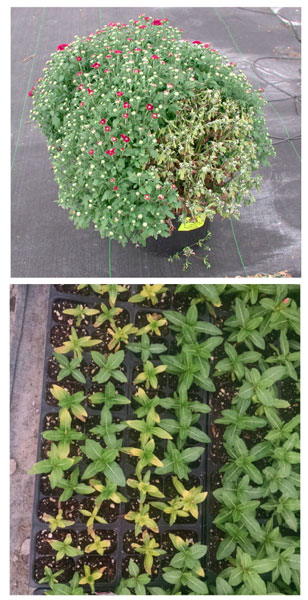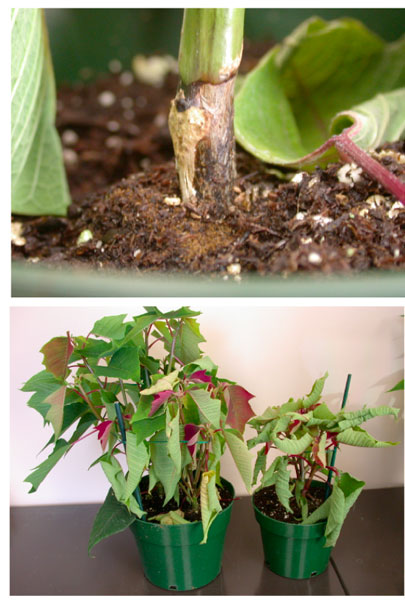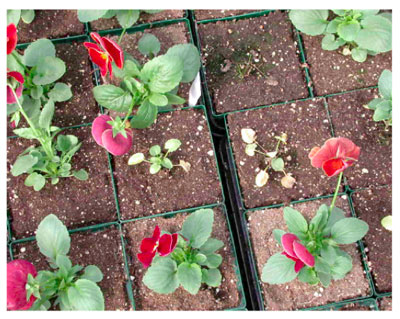7/1/2022
Common Root Diseases
Nathan Wallace-Springer

Root diseases present constant challenges for both professional and home growers alike in the greenhouse. In order for root diseases to develop, three components must be present: 1) a susceptible host; 2) an environment conducive to the pathogen; and 3) an appropriate pathogen. This is often referred to as the root disease triangle.
The two most common causes of root impairment in plants are due to over-fertilization and pathogenic fungi. Understanding these potential threats and environmental conditions that can affect plant health are the first steps that can be taken to prevent disease from developing.
Symptoms of root disease
Plants with root disease often exhibit one or more of the following characteristics: stunted growth, discolored or wilted leaves, leaf loss, soft “mushy” stems, brown or black roots, or death itself. As a grower, it’s critical to routinely monitor plants for any noticeable symptoms to prevent crop loss.
Root disease progression generally occurs in stages. In the initial stages, a healthy plant must first be made susceptible to root disease. For example, this can be caused by overfertilization, overwatering, insect damage, inadequate drainage from the media or another outside influence that causes prolonged stress to the plant. Then, if the source of the plant’s stress isn’t identified or corrected, the plant will start to weaken to the point it can become infected by a plant pathogen or be susceptible to death itself.
 Pictured: Pythium is causing the wilting, dead portion of this mum. Controlled-release fertilizer released at high rates during a heat wave can damage roots and led to Pythium infection.
Pictured: Pythium is causing the wilting, dead portion of this mum. Controlled-release fertilizer released at high rates during a heat wave can damage roots and led to Pythium infection.
Vinca infected with Fusarium. Notice plants are showing chlorosis in the new growth, indicating diseased roots cannot take up micronutrients.
Once this happens, the plant’s roots begin to die, turning from white and firm to brown and mushy, and the plant will start to wilt and lose leaves. At this point, plant roots also may appear water soaked, as they no longer take up water and foliage of the plant can appear soggy. In some cases, root colonizing pathogenic fungi will move into the stem and cause canker or “black leg.” Ultimately, these factors will culminate into the eventual death of the plant. Nevertheless, it’s important to note, depending on the plant pathogen, the visual symptoms a plant exhibits can change.
Most common root disease organisms
Pythium spp. is an oomycete, or “water mold,” that thrives in wet conditions and is one of the most common greenhouse root disease pathogens. Currently, more than 200 different species of Pythium have been identified. Although not all have been shown to be pathogenic to plants, most are still natural inhabitants of the soil that have adapted to survive in harsh conditions. Likewise, once they enter a greenhouse, they can be challenging to eliminate and may pose a threat for years to come.
Pythium is often introduced into greenhouses from infected plugs and other plant material, irrigation water pumped in from streams or ponds, or tracked in from soil residues on shoes that’s left on walkways, benches, floors, etc. In general, it’s regularly associated with excessive nutrient levels (high EC), ammonium toxicity and/or wet growing media. Using a growing medium that dries out slowly or is made up of fine particles that can become water-logged can also make plants more susceptible to Pythium attacks. Similarly, places where water pools for a long period of time can also spread Pythium, such as ebb & flood benches. Symptoms of Pythium include stunted plant growth, brown roots, wilted/discolored leaves and black leg.
Phytophthora spp. is another oomycete, like Pythium, that favors excess moisture and nitrogen fertility. However, unlike Pythium, Phytophthora species are generally more aggressive and more likely to be host-specific, but less likely to be found in greenhouses. Consequently, an emphasis should be placed on prevention with Phytophthora, as it can be exceedingly difficult to suppress with general-purpose fungicides and spores produced can survive for long periods of time.
The two most common ways this pathogen is introduced to greenhouses is from infected plant material that’s been brought into greenhouses or from irrigation water pumped from nearby sources, such as lakes or retention ponds. Once inside, this pathogen is typically responsible for root/crown rot and blackened cankers, as well as foliar blights.
Rhizoctonia spp. is a soilborne fungus that primarily affects cuttings and young greenhouse transplants. This pathogen tends to prefer warm, moist media, though it will tolerate drier ones, and typically resides in the top layer of soil where a high percent of organic matter is present. Moreover, it can be identified by brown/reddish lesions that form from quickly decaying plant structures at or just below the surface of the growing medium. As the fungus develops on plants it will progress to form black cankers if favorable conditions persist.
 Pictured: Rhizoctonia causing stem rot in poinsettias. Often there’s webbing associated with the infection that runs from the stem to the growing medium. The second picture shows the associated wilting in the poinsettias.
Pictured: Rhizoctonia causing stem rot in poinsettias. Often there’s webbing associated with the infection that runs from the stem to the growing medium. The second picture shows the associated wilting in the poinsettias.
Rhizoctonia is frequently introduced into greenhouses through some form of soil contamination, such as soil residue that’s been tracked into the greenhouse from unclean hands. Insects such as fungus gnats and shore flies may also introduce and spread the fungus within a crop if the right conditions are met. Symptoms of Rhizoctonia include damping-off, root/crown rot, web blight, stem canker, and a dry or shriveled
appearance.
Thielaviopsis spp., more commonly referred to as black root rot, is a soilborne fungus that attacks the roots of weak plants. Once infected, their roots will begin to turn dark black from the pathogens’ reproductive structures, hence its name. However, unlike Rhizoctonia—which prefers warm, dry soils—Thielaviopsis favors cool, wet soils that have a pH above 6. As a result, Thielaviopsis is sometimes accidentally mistaken for an iron nutrient deficiency due to the chlorosis it creates while attacking plants, but increasing fertilization will only result in additional plant harm.
The primary way that Thielaviopsis is transmitted to greenhouses is from objects that have come into direct contact with the pathogen’s spores from soil, but it also can be transmitted by dust in wind, insects, water or infected plant material. Using a growing medium that doesn’t dry out quickly enough in low lighting conditions can increase a plant’s susceptibility to Thielaviopsis attack. Thielaviopsis symptoms include stunted growth, wilting leaves, chlorosis, black roots and plant death.
Fusarium spp. is another widespread, soilborne fungus that growers may encounter at some point. This pathogen thrives in moderate to high temperatures where moisture or humidity is high and drainage is poor, and acts by targeting plant foliage and roots. The initial symptoms appear as red lesions on the stems of plants above the media followed closely by root rot. At that time, plant growth will be visibly stunted and plants may start to experience stem discoloration, wilting and death.
 Pictured: Thielaviopsis in pansy.
Pictured: Thielaviopsis in pansy.
Fusarium can be introduced into greenhouses by several different means, such as infected seed, infected transplants, contaminated equipment or soil residue from outside. Once inside, Fusarium can be easily spread from plant to plant by root-to-root contact or via spores the pathogen creates that are splashed around during watering. Signs of Fusarium infection include crown/root rot, yellowing of plant, wilting, bulb rot and root rot.
Nathan Wallace-Springer is a Horticulture Specialist—Southeastern U.S. for Premier Tech Growers and Consumers. He can be reached at WALN@premiertech.com.
Here are 10 tips you can take to prevent and manage root disease in the greenhouse:
1. Start to identify and recognize environmental conditions that favor root diseases in the greenhouse.
2. Establish good sanitation practices, such as sterilizing tools after use and keep watering nozzles off the floor.
3. Carefully inspect incoming plant material for any signs or symptoms of disease.
4. Avoid overwatering and overfertilizing crops, and allow the growing medium to dry between waterings.
5. Reduce excessive humidity in the greenhouse and encourage air flow.
6. Routinely monitor media pH and EC throughout the growing cycle.
7. Use a PRO-MIX growing media that’s ideal for the crop and the environmental conditions present.*
8. Eradicate insects and weeds inside and the surrounding areas of the greenhouse.
9. Avoid reusing pots to prevent recontamination.
10. Get in the practice of thoroughly cleaning and sanitizing greenhouses during off-season downtime.
*PRO-MIX products that contain BIOFUNGICIDE use a natural bacterium (Bacillus pumilus PTB180) that colonizes plant roots and produces an antibiotic to suppress root diseases caused by Pythium, Rhizoctonia and Fusarium. This can help to reduce the number of fungicide drenches required to prevent and control root disease, saving time, money, energy and resources. GT